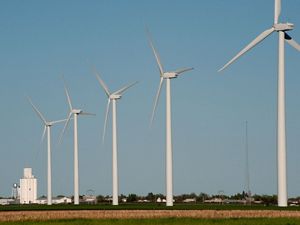New Nature Conservancy Study Says America Can Go Carbon-Free By 2050 While Benefiting Conservation and Communities
New Power of Place–National report investigates how to get to net-zero by 2050 with minimal impacts on land, water, biodiversity, and cost.
Media Contacts
-
Alessandra Clark
The Nature Conservancy
Email: alessandra.clark@tnc.org
Power of Place-National
Read the ReportToday, The Nature Conservancy (TNC) released its visionary Power of Place-National research report, which is designed to help energy planners build thoughtful net-zero strategies that maximize benefits for climate, nature, and people. The report concludes that with careful and coordinated planning and robust community engagement, the U.S. can build the clean energy infrastructure needed for economy-wide, net-zero emissions by 2050 while avoiding most impacts to sensitive natural and working lands.
To decarbonize the U.S. by 2050, renewable energy capacity needs to expand by nearly 400% and high-voltage transmission needs to increase by roughly 60%. While there are many environmental and social benefits to clean energy deployment, there are also tradeoffs for people and nature. Clean energy siting that does not consider impacts to people and nature can harm local ecosystems and create social conflict, causing project delays that slow the energy transition. Power of Place-National demonstrates that with early planning and the right incentives, negative impacts can be reduced and benefits to climate, conservation, and communities can be maximized.
“With current siting practices, an area the size of Texas is required to accommodate the wind and solar infrastructure we need to reach nationwide net-zero emissions by 2050,” said Katharine Hayhoe, Chief Scientist of TNC. “By adopting the Power of Place approach, we can significantly lower the land area needed and dramatically reduce environmental impacts on those areas. This methodology shows that we can all win, ensuring a clean energy transition that is resilient, equitable, and better for nature.”
Power of Place-National builds on TNC’s previous studies of California and the American West, which use an analytical methodology to identify clean energy technology portfolios that minimize the land-use footprint and costs. It offers a range of options to energy planners and highlights a scenario that reduces land and community impacts by 70% as compared to “siting-as-usual” practices. Under this scenario, most sensitive wildlife and habitats would go unharmed and nearly 2,000 square miles of highly productive cropland would avoid impacts from new development.
“Farmers, ranchers, and rural communities are essential to agriculture as well as to America’s clean energy future,” said John Piotti, President and CEO of American Farmland Trust. “We appreciate The Nature Conservancy’s incorporation of AFT’s Farms Under Threat data in the Power of Place-National Report. To protect our most productive farmland and food security, we need to define a balanced pathway for decarbonizing the nation’s grid and expanding transmission infrastructure. Utilizing carefully outlined guiding principles, we will accelerate deployment of solar, wind and battery storage while strengthening farm viability, empowering local communities, and safeguarding the productive agricultural lands that sustain us.”
Quote: Katharine Hayhoe
This methodology shows that we can all win, ensuring a clean energy transition that is resilient, equitable, and better for nature.
The scenario highlighted in the study shows that conservation and agricultural impact reduction would come with a projected cost increase of 6.3%, but acknowledges that this cost may be an overestimate. Projects that follow Power of Place-National recommendations may avoid costs associated with project cancellations, permitting delays, and environmental mitigation.
“Achieving net-zero by 2050 will require a generational investment,” said Ryan Jones, Co-Founder of Evolved Energy Research. “This study finds that building out the energy transition in a way that safeguards natural lands and communities has a relatively modest added cost.”
Power of Place-National also finds that renewable energy deployment would likely expand in communities that have historically been economically driven by the fossil fuel industry. New clean energy development opportunities would be provided to areas that are home to nearly 23 million people.
“The scale of development required for the clean energy transition is larger than the U.S. last saw when we built out the national highway system between the 1950s and 1980s,” said Jason Albritton, Director of the North America Climate Mitigation Program at The Nature Conservancy. “When we rise to meet this challenge through thoughtful planning and siting policies and robust community engagement, the United States has the potential to decarbonize by 2050 while preserving ecosystems and improving the lives of millions of Americans.”
Anyone interested in helping shape a healthier energy future that achieves climate goals while protecting our communities, working lands, and wildlife can download the report at www.nature.org/powerofplace.
The Nature Conservancy is a global conservation organization dedicated to conserving the lands and waters on which all life depends. Guided by science, we create innovative, on-the-ground solutions to our world’s toughest challenges so that nature and people can thrive together. We are tackling climate change, conserving lands, waters and oceans at an unprecedented scale, providing food and water sustainably and helping make cities more sustainable. The Nature Conservancy is working to make a lasting difference around the world in 81 countries and territories (40 by direct conservation impact and 41 through partners) through a collaborative approach that engages local communities, governments, the private sector, and other partners. To learn more, visit nature.org or follow @nature_press on X.


